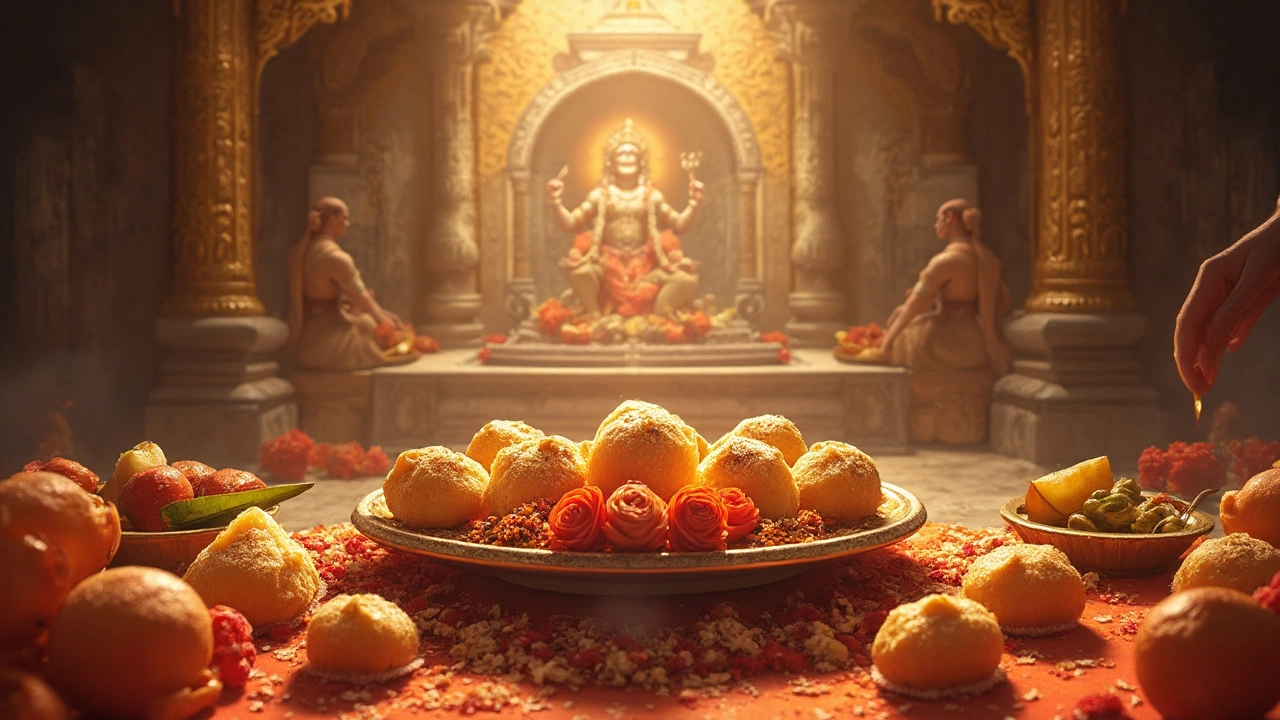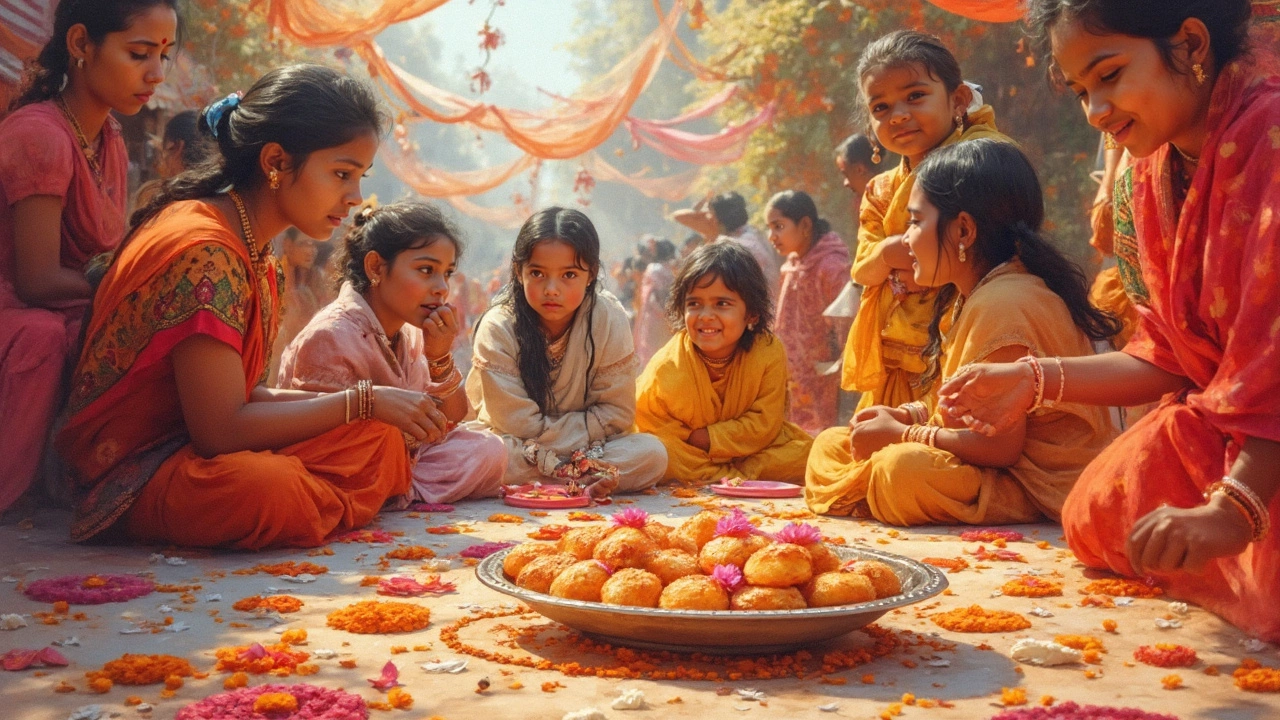If you've ever been to a Hindu festival or ceremony, you'd know it's not complete without a generous serving of sweets, or 'mithai' as they're called. There's something about those colorful, sugary treats that feels just right. But why is giving sweets such an essential part of Hindu traditions? Well, it’s more than just satisfying a sweet tooth.
Sweets symbolize auspiciousness and positivity. In Hindu culture, they're a gesture of goodwill and happiness, often given during significant life events like weddings, births, and religious rites. They're also intrinsic to festivals like Diwali and Holi, where sharing joy is at the heart of celebrations.
- The Sweet Symbolism
- Religious Significance
- Varieties and Ingredients
- Festivals and Celebrations
- Sweets in Social Exchanges
- Homemade vs. Store-bought
The Sweet Symbolism
In Hindu culture, sweets hold a charm that's hard to resist. It's not just about indulgence; Hindu sweets carry deep symbolic significance that adds layers of meaning to their sugary taste. Every time you see a platter full of vibrant and diverse Indian sweets, remember they're more than a feast for the taste buds.
At the heart of their symbolism, sweets represent purity and positivity. This is because they're often made from pure ingredients like milk, ghee, and sugar, which are believed to cleanse the body and soul. In many Hindu rituals, sweets are offered to deities in a practice known as 'prasadam,' symbolizing a spiritual offering before being distributed to worshippers as a blessing.
Sweets also serve as a symbol of hospitality and goodwill. When visiting a Hindu home, you're likely to be welcomed with sweets. This isn't just about sharing food; it's about fostering connections, spreading happiness, and promoting good relationships. It’s amazing how a simple gesture of sharing a sweet can turn strangers into friends and strengthen bonds within communities.
A fascinating aspect of Hindu sweets is their diversity. From rich and creamy barfis to the syrupy delights of gulab jamun, each variant brings its own story and significance, often tied to specific festivals or regions. For example, modaks are deeply associated with Ganesh Chaturthi, because they are said to be Lord Ganesha's favorite.
Religious Significance
For Hindus, giving sweets isn't just about satisfying taste buds—it's deeply rooted in spirituality and faith. When it comes to religious ceremonies, offering sweets is almost as routine as the prayers themselves. These treats are not just any sweets; they're specially made to honor the gods and goddesses, each carrying its own symbolic meaning.
In Hindu rituals, sweets, known as 'prasadam,' are first offered to deities before being distributed to devotees. This practice embodies the belief that food shared with the divine acquires a spiritual essence, blessing those who consume it. Ghee-based Indian sweets, like laddus, are especially loved for these offerings, thanks to their purity and richness.
Many people don't realize this, but different Hindu traditions have specific sweets linked to particular ceremonies. For instance, modaks are famously associated with Lord Ganesha, as they're said to be his favorite. During Ganesh Chaturthi, devotees prepare and offer these to seek his blessings in overcoming obstacles and inviting prosperity.
The religious significance of sweets goes even deeper. Sweetness isn't just about the taste; it represents the inherent sweetness of life and the peace and satisfaction one seeks from spiritual practice. This makes sweets a staple during almost every religious ceremony or festival. They're like a physical representation of blessings, joy, and deity's grace all rolled into one sugary bite.
The spiritual practice of offering sweets isn't something limited to the past. It's continued unwaveringly, symbolizing that faith intertwined with tradition remains just as enriching today. So, next time you savor a piece of prasadam, remember it's not just a treat—it's a token of shared spirituality and age-old tradition.
Varieties and Ingredients
When it comes to Hindu sweets, there’s a dizzying array to choose from, each with its own unique taste and cultural significance. Common ingredients include milk, sugar, nuts, and aromatic spices, which are used in different combinations to create these delectable treats.
One of the most popular Indian sweets is the humble gulab jamun. Made by frying dough balls from milk solids and flour, these are then soaked in a sugary syrup flavored with rose water or cardamom. It's a classic, loved for its melt-in-your-mouth texture and sweetness.
Next up, we have ladoo, a versatile sweet that can be made with various base ingredients like chickpea flour, semolina, or coconut. Often rolled into round shapes, ladoos are a staple at almost every festive occasion.
A favorite during colder seasons is besan barfi. Made from gram flour, sugar, and a bit of ghee, it's cooked until it turns a golden brown and has a rich nutty flavor that's hard to resist.
Another heavenly option is jalebi, a crispy, bright orange sweet made by deep-frying flour batter in circular shapes and then dunking them in sugar syrup. It’s a crowd-pleaser, especially during weddings and celebrations.
Each region in India has its specialties. In the south, you'll find coconut-based sweets like paal payasam, while the north offers nut-heavy options like peda or kaaju katli. Variety is the spice of life, right?
Here's a little-known fact: A study showed that during major festivals, the demand for Hindu sweets increases by about 40% in India, making it a booming period for sweet shops!

Festivals and Celebrations
When it comes to Hindu festivals and celebrations, sweets like laddu, jalebi, and barfi are more than just food; they're symbols of joy and community. Diwali, arguably the most celebrated Hindu festival, is all about lights, family, and, of course, delicious sweets. During this time, families exchange sweets as a gesture of love and prosperity, lighting up not just their homes but their hearts too.
Take Holi, the festival of colors, for example. Friends and families gather to play with vibrant powders and water. But what's a good Holi without feasting on gujiya, a sweet dumpling? Sweets add a special flavor to the vibrant chaos, making memories even sweeter.
At weddings, sweets are a must. Guests are often greeted with sweet treats, a way to start the new journey with positivity and sweetness. Different regions in India have their own unique sweets for these occasions, from Bengali rasgulla to South Indian mysore pak, each bringing a distinct taste to the table.
Sweets also have religious importance during pujas or prayer ceremonies. Presenting sweets to deities is a common practice, symbolizing the offering of good intentions and seeking blessings. In many temples, special prasad, which often includes sweets, is distributed to devotees, bringing everyone together in harmony.
So, whether it's a colorful festival or a life milestone, sweets play a tempting and comforting role in Hindu celebrations, ensuring that every occasion is remembered fondly and shared lovingly.
Sweets in Social Exchanges
In the Hindu culture, exchanging sweets isn’t just for special occasions; it plays a big part in everyday social interactions too. Sweets act as a symbol of goodwill, strengthening bonds between family, friends, and even neighbors. It's like bringing a piece of your happiness to others.
Ever noticed how, if you bring a box of sweets to someone's home, it’s always met with smiles and a chai invitation? That's because in many communities, especially in India, offering sweets represents friendship, respect, and a warm welcome. It’s not just about the taste—it's the gesture that counts. Whether it's a simple box of ladoos or an elaborate assortment of burfis, the act of giving sweets is a way to say, “I care.”
During festivals like Diwali, there's often an informal competition between neighbors to share the best sweets. It's a delightful way to connect, learn new recipes, or even just indulge in each other's unique culinary skills. Plus, it's common to see sweets being exchanged for business reasons. Want to seal a deal or start a new partnership? A box of well-curated mithai might just do the trick!
Moreover, sweets can also smooth over quarrels. In many parts of India, there's a saying that goes, "Meet with sweets." That means if you're in a bit of a tiff with someone, offering sweets can help patch things up. They are, after all, the ultimate peace offering. Takes some of the bitterness out of disputes, right?
In modern times, though homemade sweets hold a special place, store-bought sweets have carved their niche too, with popular brands offering beautifully packaged options. Whether homemade or bought from your local sweet shop, the essence of giving sweets remains the same—a gesture of love and bonding.
Homemade vs. Store-bought
Ah, the age-old debate! Should you roll up your sleeves and make Indian sweets at home, or pop into a store and grab a box of ready-made ones? Both have their own charm and perks.
Let's talk homemade first. Making sweets at home is like adding a special dash of love. You know exactly what goes into them, so if you're keen on quality and hygiene, that's a big win. Plus, it's a chance to experiment with flavors and sweetness levels to suit your family's taste. On the flip side, it can be time-consuming and might not be the best idea if you're crunched for time, especially if you’re planning to make intricate sweets that require precision and patience.
Now for the store-bought goodies. They're super convenient, especially when time's not on your side. Plus, many Indian sweet shops have decades of expertise, making their sweets a class apart in taste and authenticity. Buying from a store also means you get a wide variety without having to slave away in the kitchen. But, you might not have control over the ingredients, especially if you're cautious about things like preservatives or wanting to ensure vegetarian or vegan options.
One thing's for sure, whether homemade or store-bought, Hindu traditions ensure that sweets remain at the heart of celebrations. If you're looking for the best of both worlds, how about trying a hybrid approach: experiment with a few homemade recipes during less busy times and rely on store-bought ones for bigger gatherings?
In the end, it's all about preference, time, and the vibe you want to set for your festivities. Both options can beautifully capture the sweetness of Indian celebrations and continue the cherished tradition of sharing sweets.
